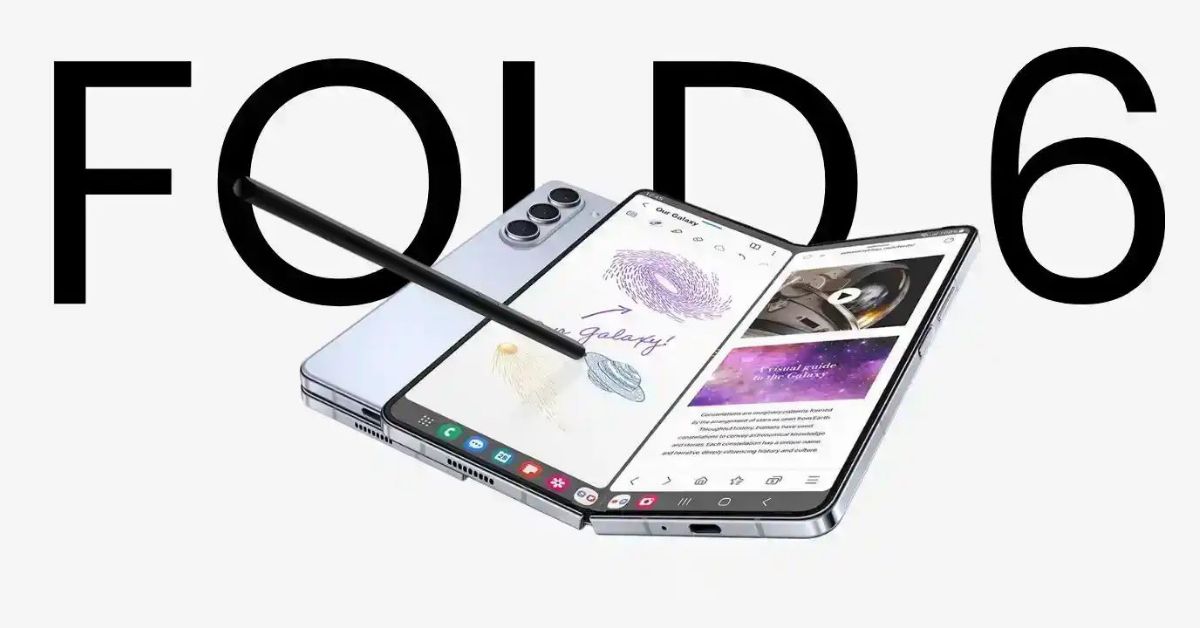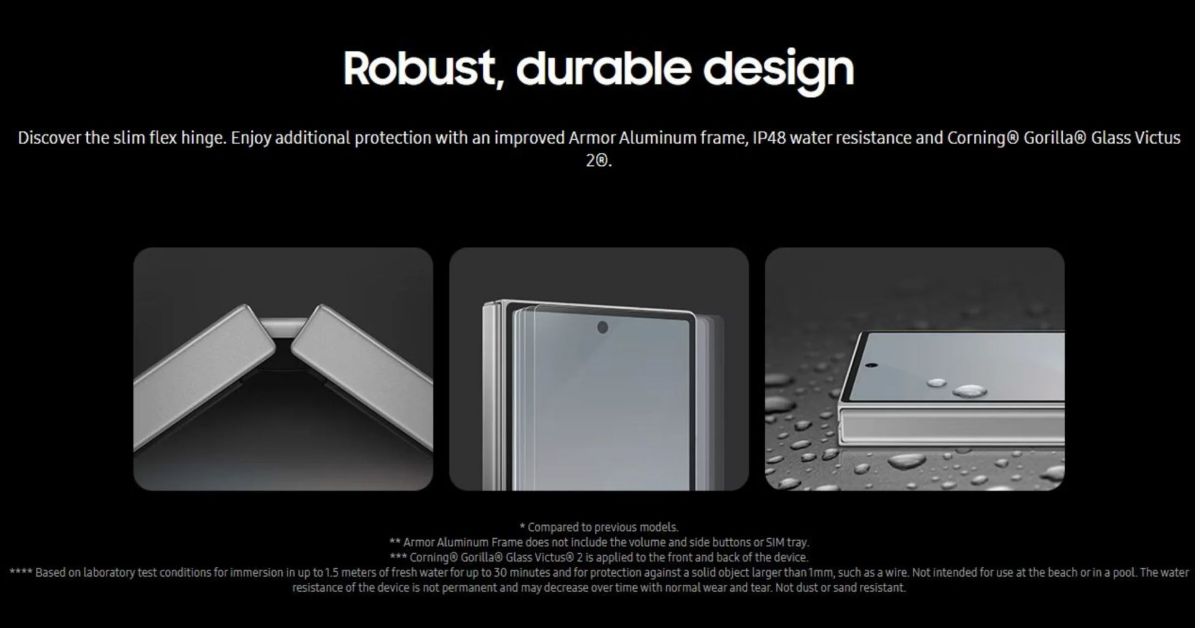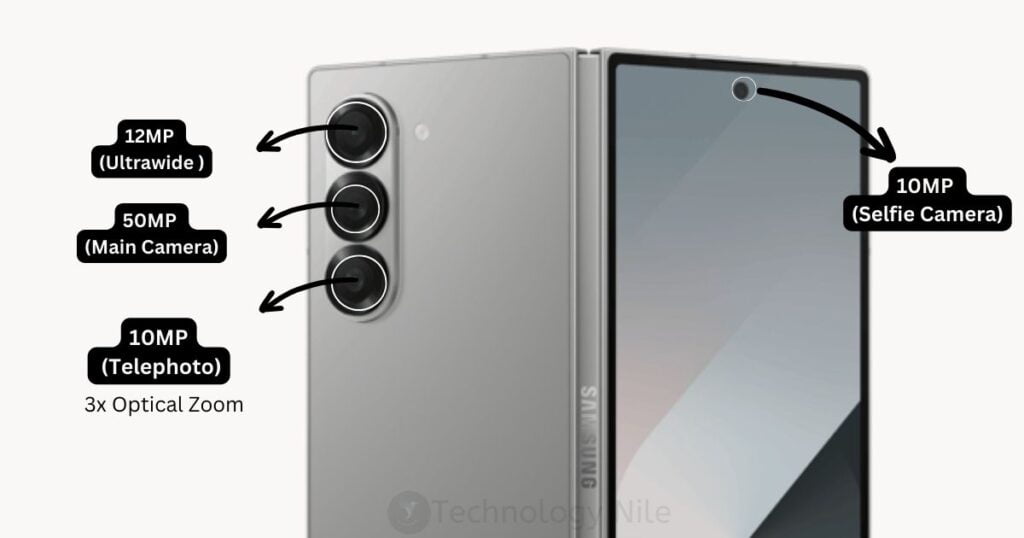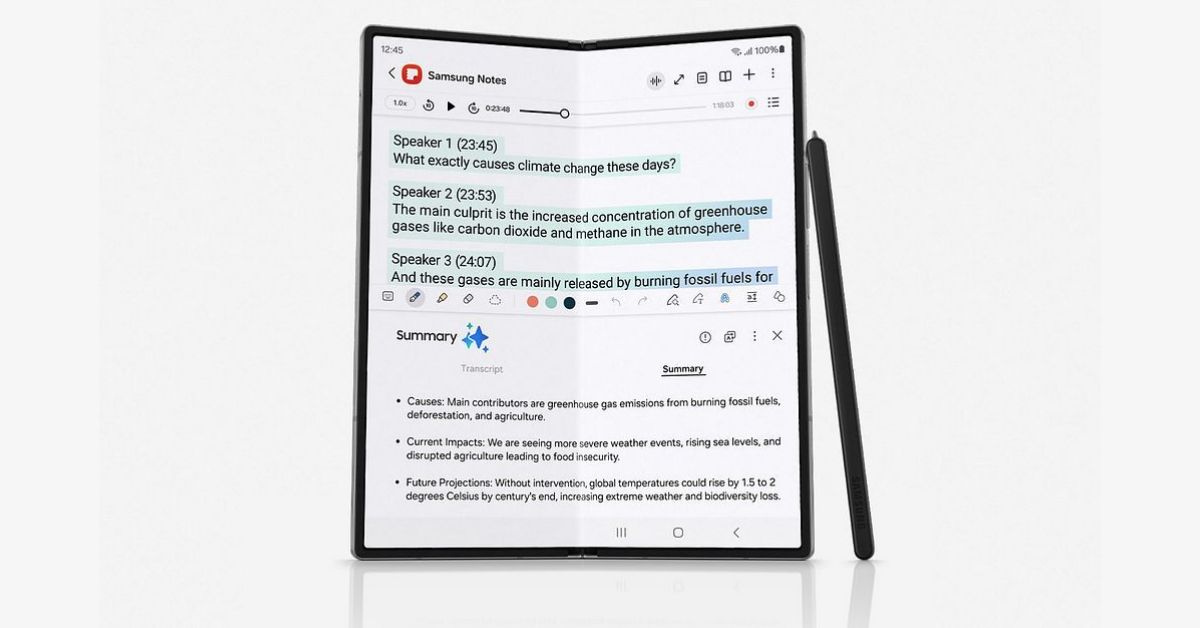


At its glamorous Unpacked event on July 10, 2024, Samsung unveiled the Galaxy Z Fold6, heralding a new era for foldable smartphones. With its book-like design, this next-gen marvel boasts an array of subtle and striking enhancements, setting a new benchmark in innovation.
Building on the legacy of the Galaxy Z Fold 5, this cutting-edge foldable phone reimagines the formula with a power boost, a refined design, and packed with artificial intelligence features.
If you're anticipating revolutionary new cameras and a sleek titanium design, prepare to be underwhelmed. On the surface, Samsung's changes may not seem groundbreaking. However, the cumulative impact of numerous subtle adjustments could be a game-changer. For an in-depth look at our initial experience with the new Fold, delve into our comprehensive hands-on review of the Samsung Galaxy Z Fold 6.
Let's look at the key improvements of the Galaxy Z Fold 6 and see if it deserves a place on our list of the best foldable phones.

The much anticipated Samsung Z Fold 6 are retailing in Singapore from $2548 for 12GB+256GB $2728 for 12GB+512GB and $3088 for 12GB+1TB variant.
Galaxy Fold phones have never been budget-friendly, but the latest price increase might be a tough pill, especially with competitors like the Google Pixel Fold and OnePlus Open offering similar features for significantly less. However, Samsung positions the Fold 6 as a premium device, packed with an array of features that might convince high-end users it is worth the value. Keep in mind, though, that Samsung still does not include an S Pen with the Fold 6, unlike its Galaxy S24 Ultra counterpart.

The Fold 6, like all new Samsung Galaxy phones, comes with a new chipset. Similar to the Galaxy S24 series, the new Fold is equipped with Qualcomm's custom-tuned Snapdragon 8 Gen 3 chipset, rather than a mass-market version.
The Snapdragon 8 Gen 2 chip was already impressive, much like the Gen 3. My Galaxy Z Fold 4 has always been speedy. So, the 14% CPU boost and 25% GPU jump in benchmarks? Not exactly thrilling.
Ray-tracing performance has increased by 53%, promising more visually stunning gaming experiences. Additionally, with a 1.6x larger vapor chamber, the Fold 6 is poised to maintain high performance longer than the Fold 5. A 41% improvement in neural processing performance indicates that the Fold 6 will deliver swift responses with its integrated AI tools; further details on these tools will be provided later.
While an increase in RAM for the Fold 6 would have been appreciated, Samsung has kept it at 12GB. Storage options are available in 256GB, 512GB, and 1TB variants. For detailed comparisons with competitors, refer to the specs table below. Additionally, my in-depth analysis provides a comprehensive look at the Samsung Galaxy Z Fold 6 specifications.

Reviewers have often found that the cover screen on Fold phones seems excessively tall and slim, making it difficult to use; Samsung might have addressed this problem with this design adjustment.
The Fold 6 is slightly slimmer by a millimeter or two and weighs 239g compared to the Fold 5's 252.3g. Consequently, the new Fold offers a more pleasant feel in the hand. Additionally, with an enhanced dual-rail hinge that can endure shocks and pressure more effectively, and a 10% stronger 'Armor Aluminium' chassis, the overall durability of this foldable phone has been significantly improved.

It's somewhat disappointing that Samsung chose not to include the 200-megapixel main camera from the Galaxy S24 Ultra in the Galaxy Z Fold 6, especially given the high price of the latter. Instead, the South Korean tech company opted to stick with a 50MP main camera, similar to the one in the Fold 5.
A Samsung representative explained that due to the AI processing and enhanced image signal processing, a higher resolution main camera sensor is unnecessary.
The telephoto lens has also maintained a 10x telephoto capability with a 3x optical zoom. That's acceptable, but it probably won't rival the 5x optical zoom of the iPhone 15 Pro Max's periscope lens.
Nonetheless, the ultra-wide lens is novel. Even though it retains a 12MP sensor, aperture, and pixel dimensions, Samsung claims the lens has enhanced low-light photography due to a specialized image signal processing unit. Additionally, it can now take HDR pictures.
A minor enhancement, but incorporating AI capabilities still results in a highly adaptable camera setup, particularly when you consider the front-facing camera and an under-display camera on the foldable screen. All of this is aided by Samsung's ProVision engine receiving a comprehensive upgrade, which is expected to produce superior photos that are more balanced in terms of hues and contrast.

The Galaxy Z Fold 6 operates on Android 14 with One UI 6.1.1 layered over it. Consequently, you will have functionalities such as improved lock screen personalization and Magic Compose, which offers intelligent replies to messages in various tones.
However, the noteworthy aspect here is the integration of Samsung's Galaxy AI. We have already observed this with Generative Edit on the Galaxy S24 series, which allows you to essentially reconstruct a photo using AI to complete missing parts or become quite creative with a real-world image.
A new transcription functionality is now available for the Note app that can summarize one's notes. Additionally, a new Composer feature in the Samsung Keyboard can create text based on basic keywords for emails, social media updates, and comments.
Possibly the most intelligent new AI function is how the Interpreter application can operate across the Fold 6's screens by offering a dialogue mode that displays two-way translations on the primary and cover screens, the concept being it facilitates more natural interactions between two individuals speaking different languages. Real-Time Translation also functions in third-party applications.
| Network | Technology | GSM / CDMA / HSPA / EVDO / LTE / 5G |
|---|---|---|
| 2G bands | GSM 850 / 900 / 1800 / 1900 - SIM 1 & SIM 2 (dual-SIM model only) CDMA 800 / 1900 | |
| 3G bands | HSDPA 850 / 900 / 1700(AWS) / 1900 / 2100 CDMA2000 1xEV-DO | |
| 4G bands | 1, 2, 3, 4, 5, 7, 8, 12, 13, 17, 18, 19, 20, 25, 26, 28, 32, 38, 39, 40, 41, 66 - International | |
| 5G bands | 1, 2, 3, 5, 7, 8, 12, 20, 25, 26, 28, 38, 40, 41, 66, 75, 77, 78 SA/NSA/Sub6 - International | |
| Speed | HSPA, LTE-A (CA), 5G | |
| GPRS | Yes | |
| EDGE | Yes | |
| Launch | Announced | 2024, July 10 |
| Status | Coming soon. Exp. release 2024, July 24 | |
| Body | Dimensions | Unfolded: 153.5 x 132.6 x 5.6 mm Folded: 153.5 x 68.1 x 12.1 mm |
| Weight | 239 g | |
| Build | Glass front (Gorilla Glass Victus 2) (folded), plastic front (unfolded), glass back (Gorilla Glass Victus 2), aluminum frame Stylus support | |
| SIM | Up to two Nano-SIM and multi eSIM IP48 water resistant (up to 1.5m for 30 min) Samsung Pay (Visa, MasterCard certified) | |
| Display | Type | |
| Size | 7.6 inches, 185.2 cm2 (~91.0% screen-to-body ratio) | |
| Resolution | 1856 x 2160 pixels (~374 ppi density) Cover display: Dynamic LTPO AMOLED 2X, 120Hz, 2600 nits (peak), Corning Gorilla Glass Victus 2 6.3 inches, 968 x 2376 pixels, 410 ppi | |
| Multitouch | Yes | |
| Protection | Corning Gorilla Glass 5 | |
| - HDR10+ compliant - Always-on display | ||
| Platform | OS | Android 14, One UI 6.1.1 |
| Chipset | Qualcomm SM8650-AC Snapdragon 8 Gen 3 (4 nm) | |
| CPU | 8-core (1x3.39GHz Cortex-X4 & 3x3.1GHz Cortex-A720 & 2x2.9GHz Cortex-A720 & 2x2.2GHz Cortex-A520) | |
| GPU | Adreno 750 (1 GHz) | |
| Memory | Card slot | No |
| Internal | 256GB 12GB RAM, 512GB 12GB RAM, 1TB 12GB RAM UFS 4.0 | |
| Main Camera | Triple | 50 MP, f/1.8, 23mm (wide), 1.0µm, dual pixel PDAF, OIS 10 MP, f/2.4, 66mm (telephoto), 1.0µm, PDAF, OIS, 3x optical zoom 12 MP, f/2.2, 123˚, 12mm (ultrawide), 1.12µm |
| Features | LED flash, auto-HDR, panorama | |
| Video | 8K@30fps, 4K@60fps, 1080p@60/120/240fps (gyro-EIS), 720p@960fps (gyro-EIS), HDR10+ | |
| Selfie camera | Single | 4 MP, f/1.8, 26mm (wide), 2.0µm, under display Cover camera:10 MP, f/2.2, 24mm (wide), 1/3", 1.22µm |
| Features | Dual video call, Auto-HDR | |
| Video | 4K@30/60fps, 1080p@30/60fps, gyro-EIS | |
| Sound | Alert types | Vibration; MP3, WAV ringtones |
| Loudspeaker | Yes, with stereo speakers | |
| 3.5mm jack | No | |
| - 32-bit/384kHz audio Tuned by AKG | ||
| Comms | WLAN | Wi-Fi 802.11 a/b/g/n/ac/6e, tri-band, Wi-Fi Direct |
| Bluetooth | 5.3, A2DP, LE, aptX HD | |
| GPS | GPS, GLONASS, GALILEO, BDS | |
| NFC | Yes | |
| Radio | No | |
| USB | USB Type-C 3.2, USB On-The-Go | |
| Features | Sensors | Fingerprint (side-mounted), accelerometer, gyro, proximity, compass, barometer Ultra Wideband (UWB) support Samsung DeX (desktop experience support) |
| Messaging | SMS(threaded view), MMS, Email, Push Email, IM | |
| Browser | HTML5 | |
| Charging | - 25W wired, QC2.0, 50% in 30 min (advertised) - 15W wireless - 4.5W reverse wireless | |
| Battery | Li-Po 4400 mAh, non-removable | |
| Misc | Colors | Navy, Silver Shadow, Pink, Black, White |
| Model | SM-F956B |
|---|---|
| FreeGift | No |
| Warranty | 1 year local mfg warranty |
| Options | No |
| Frame Strip | N/A |
| Housing | No |
| LCD Replacement | No |
| Battery Replacement | No |
| Network | Technology | GSM / CDMA / HSPA / EVDO / LTE / 5G |
|---|---|---|
| 2G bands | GSM 850 / 900 / 1800 / 1900 - SIM 1 & SIM 2 (dual-SIM model only) CDMA 800 / 1900 | |
| 3G bands | HSDPA 850 / 900 / 1700(AWS) / 1900 / 2100 CDMA2000 1xEV-DO | |
| 4G bands | 1, 2, 3, 4, 5, 7, 8, 12, 13, 17, 18, 19, 20, 25, 26, 28, 32, 38, 39, 40, 41, 66 - International | |
| 5G bands | 1, 2, 3, 5, 7, 8, 12, 20, 25, 26, 28, 38, 40, 41, 66, 75, 77, 78 SA/NSA/Sub6 - International | |
| Speed | HSPA, LTE-A (CA), 5G | |
| GPRS | Yes | |
| EDGE | Yes | |
| Launch | Announced | 2024, July 10 |
| Status | Coming soon. Exp. release 2024, July 24 | |
| Body | Dimensions | Unfolded: 153.5 x 132.6 x 5.6 mm Folded: 153.5 x 68.1 x 12.1 mm |
| Weight | 239 g | |
| Build | Glass front (Gorilla Glass Victus 2) (folded), plastic front (unfolded), glass back (Gorilla Glass Victus 2), aluminum frame Stylus support | |
| SIM | Up to two Nano-SIM and multi eSIM IP48 water resistant (up to 1.5m for 30 min) Samsung Pay (Visa, MasterCard certified) | |
| Display | Type | |
| Size | 7.6 inches, 185.2 cm2 (~91.0% screen-to-body ratio) | |
| Resolution | 1856 x 2160 pixels (~374 ppi density) Cover display: Dynamic LTPO AMOLED 2X, 120Hz, 2600 nits (peak), Corning Gorilla Glass Victus 2 6.3 inches, 968 x 2376 pixels, 410 ppi | |
| Multitouch | Yes | |
| Protection | Corning Gorilla Glass 5 | |
| - HDR10+ compliant - Always-on display | ||
| Platform | OS | Android 14, One UI 6.1.1 |
| Chipset | Qualcomm SM8650-AC Snapdragon 8 Gen 3 (4 nm) | |
| CPU | 8-core (1x3.39GHz Cortex-X4 & 3x3.1GHz Cortex-A720 & 2x2.9GHz Cortex-A720 & 2x2.2GHz Cortex-A520) | |
| GPU | Adreno 750 (1 GHz) | |
| Memory | Card slot | No |
| Internal | 256GB 12GB RAM, 512GB 12GB RAM, 1TB 12GB RAM UFS 4.0 | |
| Main Camera | Triple | 50 MP, f/1.8, 23mm (wide), 1.0µm, dual pixel PDAF, OIS 10 MP, f/2.4, 66mm (telephoto), 1.0µm, PDAF, OIS, 3x optical zoom 12 MP, f/2.2, 123˚, 12mm (ultrawide), 1.12µm |
| Features | LED flash, auto-HDR, panorama | |
| Video | 8K@30fps, 4K@60fps, 1080p@60/120/240fps (gyro-EIS), 720p@960fps (gyro-EIS), HDR10+ | |
| Selfie camera | Single | 4 MP, f/1.8, 26mm (wide), 2.0µm, under display Cover camera:10 MP, f/2.2, 24mm (wide), 1/3", 1.22µm |
| Features | Dual video call, Auto-HDR | |
| Video | 4K@30/60fps, 1080p@30/60fps, gyro-EIS | |
| Sound | Alert types | Vibration; MP3, WAV ringtones |
| Loudspeaker | Yes, with stereo speakers | |
| 3.5mm jack | No | |
| - 32-bit/384kHz audio Tuned by AKG | ||
| Comms | WLAN | Wi-Fi 802.11 a/b/g/n/ac/6e, tri-band, Wi-Fi Direct |
| Bluetooth | 5.3, A2DP, LE, aptX HD | |
| GPS | GPS, GLONASS, GALILEO, BDS | |
| NFC | Yes | |
| Radio | No | |
| USB | USB Type-C 3.2, USB On-The-Go | |
| Features | Sensors | Fingerprint (side-mounted), accelerometer, gyro, proximity, compass, barometer Ultra Wideband (UWB) support Samsung DeX (desktop experience support) |
| Messaging | SMS(threaded view), MMS, Email, Push Email, IM | |
| Browser | HTML5 | |
| Charging | - 25W wired, QC2.0, 50% in 30 min (advertised) - 15W wireless - 4.5W reverse wireless | |
| Battery | Li-Po 4400 mAh, non-removable | |
| Misc | Colors | Navy, Silver Shadow, Pink, Black, White |